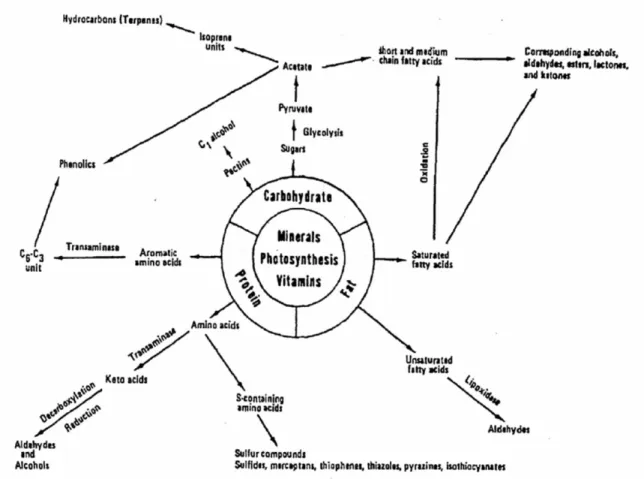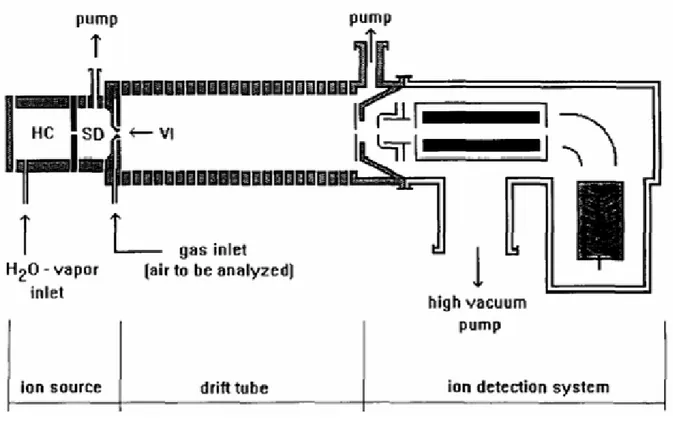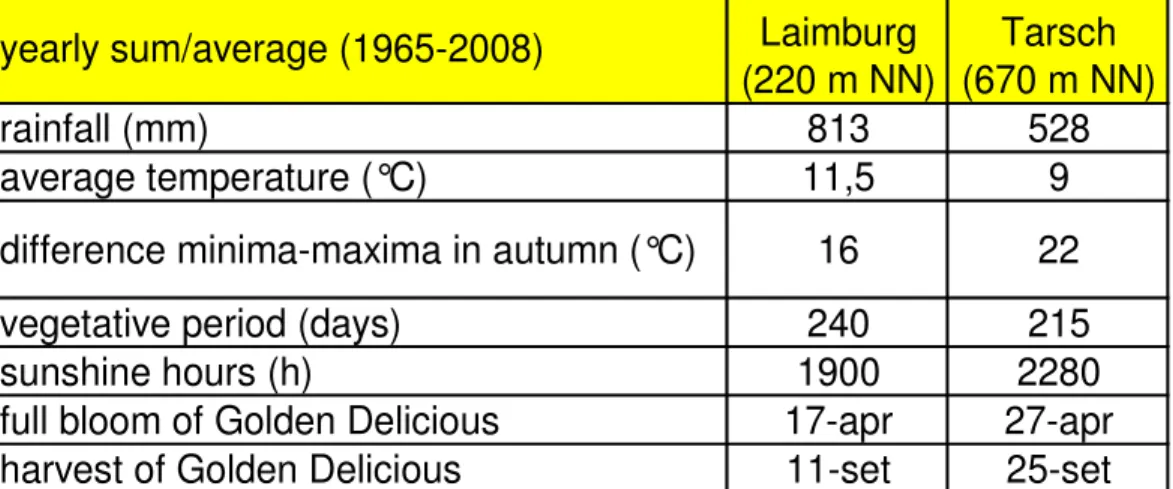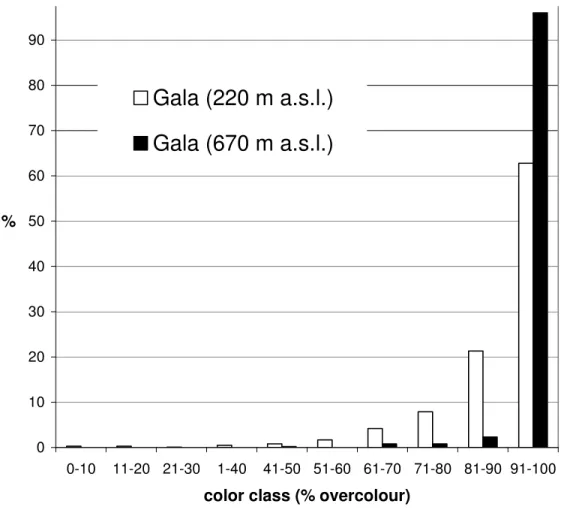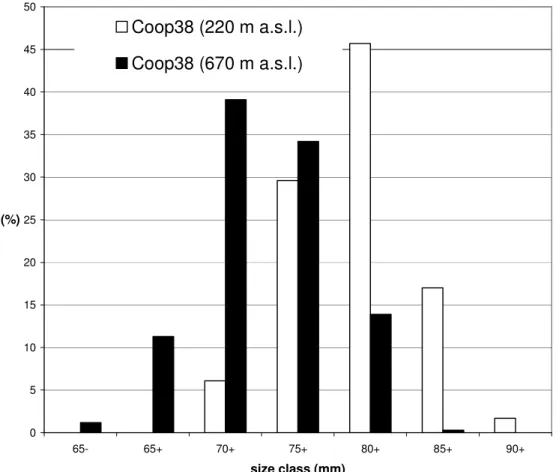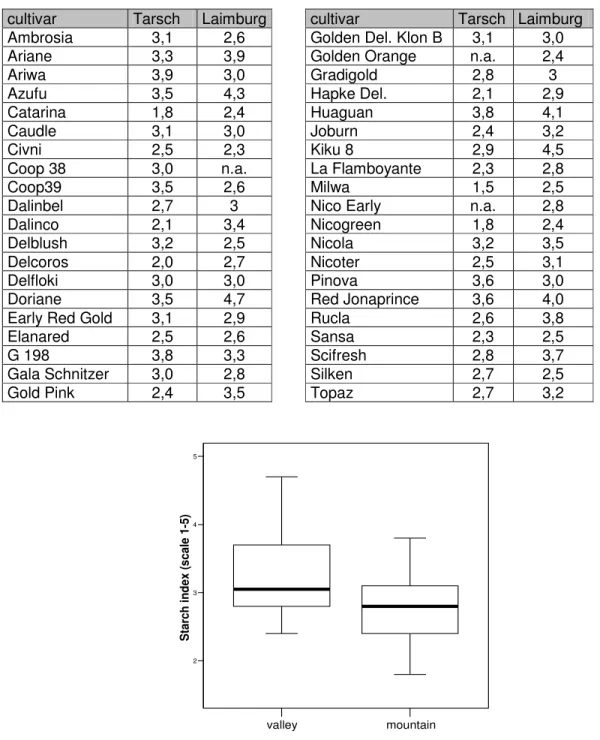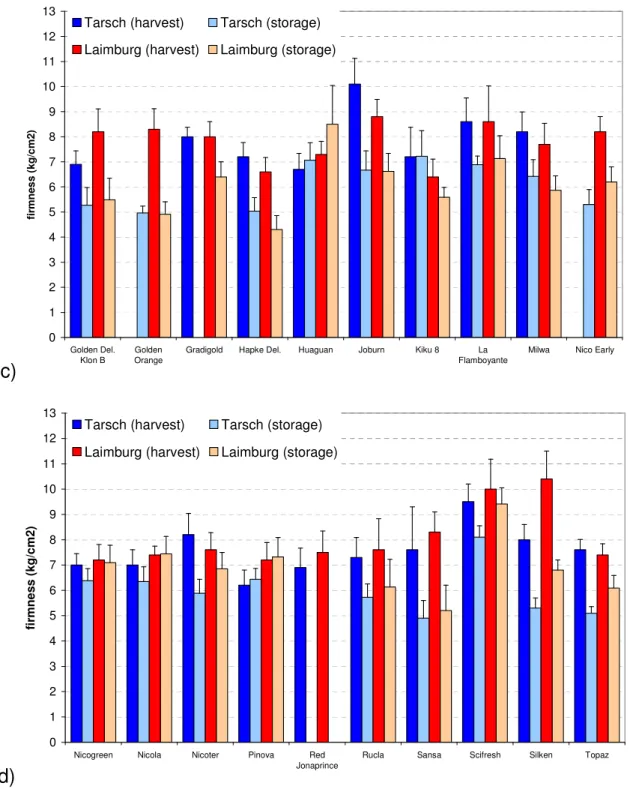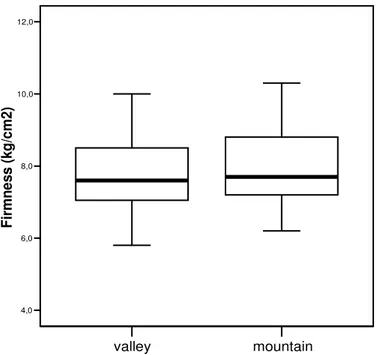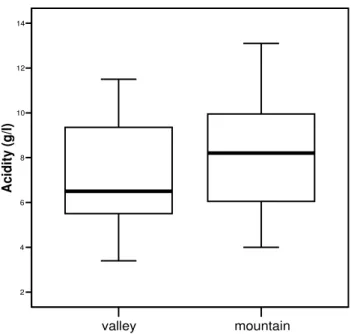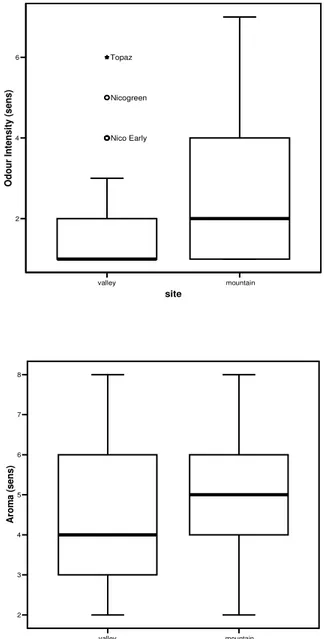A
A
l
l
m
m
a
a
M
M
a
a
t
t
e
e
r
r
S
S
t
t
u
u
d
d
i
i
o
o
r
r
u
u
m
m
–
–
U
U
n
n
i
i
v
v
e
e
r
r
s
s
i
i
t
t
à
à
d
d
i
i
B
B
o
o
l
l
o
o
g
g
n
n
a
a
DOTTORATO DI RICERCA
COLTURE ARBOREE ED AGROSISTEMI
FORESTALI ORNAMENTALI E PAESAGGISTICI
Ciclo
XXISettore scientifico disciplinare di afferenza:
AGR/03 ARBORICOLTURA GENERALE E COLTIVAZIONI ARBOREE
TITOLO TESI
Comparison of apple cultivars based on volatile
organic compounds (VOC) release determined by
Proton Transfer Reaction Mass Spectrometry.
Presentata da:
Dott. Walter Guerra
Coordinatore Dottorato
Relatore
Prof. Luca Corelli Grappadelli
Prof. Silviero Sansavini
Index
1 INTRODUCTION ... 4
1.1 Odour and flavour ... 4
1.2 Measuring odour and flavour ... 5
1.3 Volatile compounds in food ... 6
1.4 Aroma of apples ... 7
1.5 Metabolism of apple aroma compounds... 11
1.6 Aroma differences between cultivars ... 13
1.7 Sensorial evaluation... 15
1.8 Instrumental techniques for VOC detection ... 16
1.8.1 Gas chromatography and Gas chromatography-olfactometry (GC-O) ... 17
1.8.2 Gas Chromatography–Mass Spectrometry (GC–MS) ... 19
1.8.3 Electronic nose ... 20
1.8.4 Proton Transfer Reaction Mass Spectrometry (PTR-MS) ... 21
1.9 Applications of PTR-MS ... 23
1.10 PTR-MS studies on fruits ... 24
1.11 The South Tyrolean fruit industry ... 26
1.12 Storage of apples ... 27
1.13 Objective of the study ... 29
1.13.1 Part 1 ... 29
1.13.2 Part 2 ... 29
2 PART 1 ... 30
2.1 Materials and Methods ... 30
2.1.1 Fruit materials ... 30
2.1.2 Biometric, physical and chemical evaluations on fruits ... 30
2.1.3 Sensorial evaluation ... 31
2.1.4 PTR-MS analysis ... 32
2.1.5 Statistical analysis ... 34
2.2 Results and discussion ... 36
2.2.1 Biometric, physical and chemical evaluations on fruits ... 36
2.2.1.1 Starch content ... 39
2.2.1.2 Firmness ... 41
2.2.1.3 Soluble solids content ... 44
2.2.1.4 Acidity ... 47
2.2.2 Sensorial analysis ... 49
2.2.3 Correlation between instrumental and sensorial analysis ... 53
3 PART 2 ... 73
3.1 Materials and Methods ... 73
3.1.1 Analysed apples, storage techniques and storage conditions ... 73
3.1.2 PTR-MS analysis ... 74
3.1.3 Data analysis ... 75
3.2 Results and discussion ... 75
3.2.1 PTR-MS peak analysis ... 75
3.2.2 Shelf-life of apples ... 81
4 CONCLUSIONS ... 91
5 ACKNOWLEDGEMENTS ... 96
1 Introduction
1.1 Odour and flavour
A volatilized chemical compound, in general at a rather low concentration, that living organisms can perceive by the olfactory sense, is called odour. Our world is full of odours which are the result of volatile compounds produced and emitted by plants. Every plant produces a characteristic volatile compound profile which results in a unique odour complex. The volatile compounds have a large range of biological functions including attraction of pollinators and seed dispersers, repelling herbivorous insects, recruiting predators of insect herbivores etc. (Gan05; Pic02).
A similar term to odour is smell, which can be used for both unpleasant and pleasant odours. The food and cosmetic industry uses the terms aroma, fragrance and scent to characterize a pleasant odour. They are sometimes used to refer to perfumes. On the other hand, malodorous, raunchy, stench, reek and stink specifically describe unpleasant odours.
The perception of odour is a complicated process which is not explainable by simple models. In general, a two-step process occurs when we are perceiving odours: a physiological part is followed by a psychological phase. First of all, in the physiological part, there is the sense of stimulus by nose receptors. Then, in the psychological part those stimuli are processed by a specific region of the human brain that is responsible for smelling. Resuming this, odour perception is the result of the processing of the stimulation of olfactory receptors by volatile compounds. Hundreds of compounds simultaneously influence the human olfactory receptors and the physiological response is far from linear, the overall effects not just being the overlapping of the effect of single stimuli (Law99). As a conclusion, odour feelings are strictly individual perceptions: personal reactions are amongst many others definitely related to age, gender, state
of health and private affectations. Further complications arise from the interplay of environmental and subjective effects.
In fact, the odour consisting of the volatile compounds in the headspace above the food gives a first flavour impression and highly influences the acceptability and judgment of any food. The whole sensory impression of food or other substance is called flavour. It is mainly determined by the combination and interaction of the chemical senses of taste and smell. Flavour perception in humans involves three distinct sensory systems (olfactory, gustatory and trigeminal) that respond to food components. These three sensory systems, however, are influenced greatly by many other properties of the foods in which these flavour stimuli are released. Texture and many others contribute indirectly to flavour perception. Volatile compounds stimulate the olfactory sensory organs in the roof of the nasal cavity. On the other hand, the trigeminal sense, a system that is dependent on free nerve endings in the eyes, nose and mouth, is stimulated by the presence of coolness, heat, astringency, acridness and pungency. Of the three chemical senses, smell is the main determinant of a food's flavour. While the taste of food is limited to sweet, sour, bitter, salty, and savoury – the basic tastes – the smells of a food are potentially limitless. A food's flavour, therefore, can be easily altered by changing its smell while keeping its taste similar.
The flavour in plants is a complex mixture of volatile compounds, to which a wide range of biochemical pathways in the plant contribute. The bouquet of flavour compounds is very sensitive to breeding, cultivation and storage.
1.2 Measuring odour and flavour
Nowadays, traits such as flavour and aroma are of increasing importance for the consumer. Along with food appearance and texture, food aroma appreciation is one of the first evaluation signals encountered by consumers during eating of food. Therefore there is an increasing need to
develop tools to quantify those traits in an objective and reproducible way. Having said this, we still have to keep in mind that it is impossible to have a fully objective and representative analytical measure of odour and flavour. A quite useful tool to measure in a rather reproducible and reliable way the components of odour and flavour of food is the sensory descriptive analysis, in particular Quantitative Descriptive Analysis (QDA) (Sto98). Correlating descriptive data and the instrumental determination of volatile compounds is difficult, because there is a difference between the complexity of the perception mechanisms and the few attributes usually addressed by descriptive analysis. It is definitely questionable if the ensemble of single attributes measured by descriptive techniques can provide a valid description of the overall sensory experience (Law98).
The situation outlined above has been significantly improved by the emergence of two important new approaches: first, innovative instrumental techniques are available nowadays, which seem to be able to compete with the sensitivity of the human receptors and at the same time, to analyse directly the genuine mixture interacting with our senses, without any extraction/concentration procedure. Secondly, new statistical multivariate methods (both for sensory and instrumental data) enable to work with high dimensional and high collinear data. Descriptive sensory methods are indeed expensive and time-consuming. The chance and possibility to calibrate their results with instrumental data has an important applicative relevance. These tools could revolutionize research on consumer preference and acceptance. It is well known that food characteristics like flavour and aroma strongly influence consumer acceptability and preference judgement.
1.3 Volatile compounds in food
than 6900 volatiles have been identified in foods and beverages (Mis96). The progress in instrumental analysis, especially but not only concerning gas chromatography-olfactometry methods, is continuously enlarging this list of volatiles (Rut01).
Only a limited number of the volatile compounds in food shows characteristics of odours, as defined above, and is as a consequence sensorially relevant. These restricted numbers of volatile compounds play a crucial role in the specific odour of a food product, commonly defined as ‘‘odour active compounds’’. The distinction between odour active compounds and whole range of volatiles in a food product was suggested by flavour chemists to be a very important task in flavour analysis (Gro93).
1.4 Aroma of apples
For more than 50 years the volatile flavour constituents of apples have been studied. Those studies have been extensively reviewed (Dim83). In the first phase, until the late 1970s, most research on aroma and flavours of apple fruit focused on identifying volatiles produced by ripening fruit (Tre75). Analytical investigations were performed under the assumption that all the volatiles occurring in apple contribute to its aroma.
Recent reviews have discussed metabolic aspects, since part of the research later on has been concentrating on the biochemical origin of aroma volatiles. Lots of improvements occurred in the development of methods for separation and identification of volatile compounds, often in trace amounts of a few parts per million. Researchers have been using these new methods to examine in more detail biosynthetic pathways and control mechanisms in the synthesis and subsequent accumulation and release of volatiles from apples.
It is known apple aroma is due to a complex mixture of volatile compounds. Only a few of the aroma compounds present in volatile emissions from apples influence and define characteristic apple aroma or taste (Cun86). A
relatively small amount of the compounds emanating from apples have been determined to have a decisive impact on the sensory quality and are, therefore, designated as impact compounds in apple fruits. The biggest challenge has been to separate the few most important flavour compounds, which might be trace chemicals, from the vast amount of inactive compounds.
The typical apple aroma is known to be the result of more than 300 volatile compounds including alcohols, aldehydes, esters, ketones and ethers (Dim83, Pai90). On average it is estimated that 78-92% are esters and 6-16% alcohols. In fact, the majority of apple aroma compounds are volatile esters. Apple fruit volatile esters contribute to fruit quality and influence consumer acceptance (Dai96; Dev95; Dix00; Har03). However, apples for example also produce a relatively large amount of α-farnesene (Bra93; Gir95; Oli92).
The apple-like or fruity smell in various cultivars of apple is due to esters (Fel93). The most commonly reported impact compounds in apples are ethyl acetate, ethyl butyrate and methyl anthranilate (Kak86). Compounds known to possess green apple-like odours are hexanal and trans-2-hexenal (Fla67, Fuh02). These compounds are not present in significant amounts in whole apples; they are formed after disruption of the cells during processing or chewing. Other compounds, such as butan-1-ol (which possesses a sweet aroma), or ethyl butanoate and ethyl 2-methylbutanoate (which are responsible for a fruity, estery aroma), contribute to apple aroma characteristics as well as to aroma intensity (Dix00).
Resuming this, about twenty chemicals have been reported to be "character impact" compounds (Table 1).
Table 1: Important apple volatile compounds and their sensory descriptions
Compound Sensory
description Cultivar Reference
Aldehydes
acetaldehyde green/sharp Golden Delicious Riz89
trans-2-hexenal green/sharp Golden Delicious Riz89
overall intensity Mclntosh Pan80
green apple Delicious Fla69
harmonious, fruity many Due79
hexanal green/sharp,
earthy Golden Delicious Riz89
overall intensity Mclntosh Pan80
good, green apple Delicious Fla69
grass like many Due79
Alcohols
butan-1-ol overall flavour,
aroma,
Royal Gala,
Golden You96
sweet aroma Delicious Riz89
hexan-1-ol earthy, unpleasant Golden Delicious Riz89
trans-2-hexenol harmonious, fruity many Due79
Esters
butyl acetate red apple aroma Royal Gala You96
Cox-like aroma Cox's Orange
Pippin Wil77c
harmonious many Due79
nail polish Gala Plo98
pentyl acetate banana like Cox's Orange
Pippin Wil77c
apple, fruity Golden Delicious Riz89
Gala Gala Plo98
hexyl acetate red apple aroma Royal Gala You96
characteristic apple
Cox-like aroma Cox's Orange
Pippin Wil77c
ripe Golden
Delicious Golden Delicious Riz89
sweet fruity, apple
2 methyl butyl acetate overall aroma, Royal Gala You96 characteristic
apple
solvent Gala Plo98
banana like Cox's Orange
Pippin Wil77c
ethyl butanoate fruity, estery Golden Delicious Riz89
harmonious, fruity many Due79
ethyl-2-methyl
butanoate fruity Golden Delicious Riz89
apple like Delicious Fla67
sweet strawberry Gala Plo98
4-methoxyallyl
benzene spicy, aniseed many Wil77c
methyl-2-methyl
butanoate sweet fruity Gala Plo98
propyl-2-methyl butanoate
very sweet,
strawberry Gala Plo98
butyl-2-methyl
butanoate fruity, apple Gala Plo98
hexyl-2-methyl
butanoate apple, grapefruit Gala Plo98
butyl hexanoate green apple Gala Plo98
hexyl propanoate apple Gala Plo98
butyl butanoate rotten apple,
cheesy Gala Plo98
butyl propanoate fruity, apple Gala Plo98
hexyl butanoate apple Gala Plo98
hexyl hexanoate apple Gala Plo98
The different volatile compounds have a diverse organoleptic contribution, showing a range of aroma thresholds. Although some of them are present in very low concentrations they contribute to potent aroma characteristics typical of apple aroma/flavour (for example ethyl-2-methyl butanoate, Fla67). Others are related to aroma quality (e.g. ethanol, Due81) or contribute to aroma intensity (e.g. trans-2-hexenol).
The alcohols butanol and hexanol give a sensation of sweetness, while acetaldehyde and trans-2-hexenol are associated with the stinging acidity.
Furthermore the ethyl butyrate and ethyl 2-methylbutyrate correlate with the fruity flavour and the hexyl acetate with a sweet-fruity odour. Interestingly, others such as propyl, butyl, pentyl acetate or butyl butyrate do not really contribute with any specific character but their absence has been reported to have negative effects on the overall aroma (Vis93).
In a recent work (Meh06) characterization of volatile compounds contributing to apple aroma extracted by vacuum hydrodistillation was done by GC-O on commercialized fruits of Golden Delicious, Fuji, and Braeburn. It was possible to detect thirty-six odorant compounds, twenty-four of which were common to all extracts. Among these thirty-six compounds, two were tentatively identified with two different methods and twenty-five were identified with at least three identification methods. These compounds corresponded to sixteen esters, six alcohols, three aldehydes, one ketone, and one terpenoid.
Generally higher molecular weight volatiles, often having one or two hydrophobic aliphatic chains, are not found in the headspace. They are most probably trapped by waxes on the apple skin.
Apple volatile production has been categorised in many different ways, the most used categorizations have been according to aroma production pattern (Dir89), type and quantity of esters or alcohols (Dir89; Pai90), skin colour (Pai79) or C6 aldehydes (Pai90).
1.5 Metabolism of apple aroma compounds
During the ripening process the production of aroma volatiles increases. One peak is reported to be at the climacteric maximum (Son96). In general, aroma compounds are synthesised from amino acids, membrane lipids and carbohydrates (Sal76, San97, Figure 1).
Figure 1: Formation of volatile aroma in fruits and vegetables (from Sal76)
They are produced from those primary metabolites via at least four pathways. Lipids which are broken down initially through ß-oxidation, then by lipoxygenase activity produce straight chain esters (Row99). The resulting hydroperoxides are then converted first to aldehydes, then to alcohols, and finally to esters. Branched chain esters, on the other hand, are produced from the breakdown of Ile (Row96).
Fatty acids supply straight chain alcohols and acyl CoAs through ß -oxidation. Branched-chain volatiles are formed by metabolism of amino acids, in particular isoleucine, leucine and valine (Hea86). Acetyl CoA is probably synthesised mainly from pyruvate, as it is the substrate of the tricarboxylic acid cycle (Mat96). Formation of alcohols from fatty acids and
dehydrogenase. Esters are produced by combining alcohols and CoA derivatives of carboxylic acids in an oxygen-dependent reaction catalysed by alcohol acyl CoA transferase (Har85). Since acetyl CoA is the most abundant CoA present in fruit tissue, the majority of esters are acetate esters.
Several authors have indicated 3-methyl-branched volatiles as apple constituents (Maa89). On the other hand, other publications were contradictory, and only small amounts of 3-methylbutanal and 2-methyl-branched acid, esters, and alcohol were identified (Kar94). Later on it has been proved that these compounds are not genuine apple compounds (Sch98). It was proved that those compounds derive from the metabolism of microorganisms that infect apples naturally or by purposeful introduction.
1.6 Aroma differences between cultivars
The volatile compounds are indicative of the stage of fruit development and are dependent on several factors including cultivar, cultural conditions, storage time and conditions (Dim82; Ber91; Han92a,b; Boy94, Aab02). The concentration and composition for example of volatile esters in fresh and stored apples can be affected by several factors including the ripening stage at harvest (Sap77; Yah90b) and the type of storage regime (Pat74; Str88). When apples are dried, big changes occur in the fruit. Gas chromatograms of dehydrated apples showed a marked decrease in volatiles compared to fresh and frozen samples (Lee67).
The qualitative and quantitative differences in volatile ester production are highly significant among apple cultivars (Fel00; Hol05; Lòp98). That means that phenotypic differences in volatile production are apparently caused by the plant genotype, there is in fact a great variation in apple flavour chemistry due to cultivar alone. Differences in apple aroma are apparent to sensory panellists, where cultivars with strong `typical' apple aroma are
preferred (Pol81). Much effort has been made to identify the most important contributors to apple flavour in different apple varieties.
It is possible to typify the apple cultivars according to their specific volatile compounds (Dou90). Apple cultivars may be either “acetate-ester producing” such as Golden Delicious, Red Delicious, Fuji (Dix97) and Jonagored Jonagold or “non-acetate-ester producing” such as Cortland and McIntosh (Yah90a). Whereas esters in apple impart a generic fruity aroma, the spicy flavour of Jonagored Jonagold apples could be related to 4-methoxy-propenylbenzene (Wil77a).
Ester type cultivars can be categorised in a more detailed manner according to the types of esters which prevale in their aroma profile: acetate ester types (Calville Blanc, Golden Delicious), butanoate ester types (Belle de Boskoop, Canada Blanc, Richared), propanoate ester types (Reinette du Mans, Richared, Starking), and ethanolic ester types (Starking).
Yellow-skinned cultivars have been reported to produce mainly acetic acid esters and red-skinned cultivars mostly butyric acid esters. High concentrations of hexyl acetate and butyl acetate were considered to characterise Cox's Orange Pippin, Elstar, Golden Delicious, Jonagold and Jubliè Delbar, with Granny Smith, Nico, Paulared, and Summerred being characterised by high concentrations of ethyl butanoate and hexan-1-ol and Boskoop and Jacques Lebel characterised by α-farnesene and hexyl 2-methyl butanoate. Concentration of C6 aldehydes for Cox's Orange Pippin and Jonathan apples was four to five times that of Golden Delicious for hexanal and 100-fold more for trans-2-hexenol. Apple cultivars also differ in concentrations of other volatiles such as 4-methoxyllylbenzene (a spice-like aroma compound, according to an English sensory panel) which can constitute up to 0.27% of headspace volatiles in some cultivars.
The compound that had the most effect on those sensory attributes which are particularly important for the typicity of apples of the cultivar Royal Gala is 2-methylbutyl acetate (You96).
In Golden Delicious, butyl acetate and hexyl acetate together represent 60% of the total aromatic components in ripened fruit (Bra93).
1.7 Sensorial evaluation
Sensory quality of apple fruits is dependent on a number of factors including size and shape, colour, texture, taste (sweet, sour, salt and bitter sensations) and aroma (volatile compounds). Among these attributes, texture and aroma appear to be the most important for the consumer (Acr88). Since the flavour profile method was set up (Cai50), most food flavour sensory evaluation has been carried out by judge panel analysis. When correct panel selection and training are performed, sensory analysis can provide valuable information in terms of consumer response forecast and quality control (Nei88). One of the limits of this technique is represented by the difficulty of using, as an instrument, people who are often expensive, unavailable and easily influenced by external stimuli. This aspect leads to the need for rigorous and time consuming training in order to produce good-quality data. Owing to this state of the art, in the last decades there has been much research activity to find alternative instrumental techniques to classical sensory analysis. The aim is to correlate consumer or judge sensory data with chemical analysis of food aroma compounds, obtained mainly via gas chromatography - mass spectrometry (GC-MS), in order to be able to replace the former by the latter as a flavour profile evaluation technique. At the moment this goal is far from being reached, because of the fact that the GC- MS technique, until a few years ago, was 100-1000 times less sensitive than mouth and nose receptors (Mei90). Now, even though some GC-MS techniques, coupled to sample concentration procedures, have greatly enhanced the
analysis sensitivity, several limits remain and the possibility to replace the panel group by flavour profile evaluation is still unavailable.
A vocabulary for sensory profiling of fresh apples was reported in several studies (Wil77b, Wat80). Others have evaluated single attributes such as firmness, juiciness or sweetness, and correlated these to instrumental measurements (Pao93; Plo97; Wat81; You96).
1.8 Instrumental techniques for VOC detection
The measurement of volatile organic compounds (VOCs) provides an interesting way to check apples and food in general, since the amount of VOCs is often connected both with their intrinsic properties (e.g. ripening degree, defects, shelf life evolution, effect of treatments) and with the quality perceived by the consumer (Rob00).
Aroma is indeed one of the most relevant quality criteria of fruit and vegetable products, and a considerable amount of research has been
devoted to developing analytical techniques for characterizing
quantitatively and qualitatively aroma-producing compounds. Both qualitative and quantitative information is desired in order to monitor product flavour quality and ripeness and to provide quality control for fresh and processed products.
Rapid progress in aroma research was impeded primarily by slow sampling, separation, and detection methodologies. In fact, fruit aroma research is subject to a number of constraints that make more rapid analysis desirable. The seasonal nature of fruit harvest and production requires that new protocols be worked out quickly and efficiently in order to meet research ‘time windows’ established by the commodity. Typical horticultural and biochemical research requires multiple experimental treatments as part of a statistically relevant design. As a consequence sample numbers for most experiments are relatively large (tens to
hundreds). Additionally in many cases an entire study must be completed in a limited time.
Ideally, analytical methods for flavour research on horticultural products should be inexpensive, fast, solventless, relatively independent of the instrument design and adaptable to automation. They should also be applicable to gaseous and liquid samples and have a large linear dynamic range while retaining low detection limits. Furthermore, they should be able to function as a screening technique or be used in the quantitative analysis of selected volatile compounds or classes of compounds for monitoring physiological processes that ideally could be directly related to biochemical changes.
To be successful, instrumental methods are required to provide rapid, reproducible results, with continuous operation, and be cost effective. To date, the instrumental methods have lacked the ability to consistently perceive all of the key sensory attributes of interest, and predictive relationships between sensory and instrumental measures have been relatively weak and unreliable.
1.8.1 Gas chromatography and Gas chromatography-olfactometry (GC-O)
In the 1960s, gas chromatography gained an increasing importance for the investigation of apple volatiles (Dra69). In general, chromatographic techniques are standardized and have sufficiently low detection limits for flavour analysis. However, it often takes more than one hour to analyse a single sample.
Gas chromatography-olfactometry (GC-O) is a commonly used technique for analysis of odour-active flavour compounds, introduced in 1964 (Ful64) and further developed in the following decades (Fri98). Combining the capability of a capillary column to separate compounds with high sensitivity comparable to that of the human nose as a detector, GC-O has shown to
be an optimal instrument to associate odour with eluting compounds. A description of the odour can be given for each retention time corresponding to an odour-active compound (Figure 2).
Figure 2: Chromatogram of volatiles from apples (cultivar Ellison’s Orange) with aroma descriptions (from Wil77c)
Quantification can be carried out by a multitude of methods, one of which is the detection frequency method, utilizing a group of assessors (Pol97, van01). The number of assessors detecting a specific odour-active compound at the sniffing port at the same time (the frequency of detection) is used as a measure of the intensity of a compound.
1.8.2 Gas Chromatography–Mass Spectrometry (GC–MS)
In this technique, compounds are chromatographically separated before they will be detected by mass spectrometry. In GC/MS, analyte molecules are ionized by electron impact (EI) at a typical collision energy of 70 eV. This is a highly energetic ionization method, which results in extensive fragmentation of the molecules being studied. Detection and quantification of gas molecules that are present in low concentrations requires long pre-concentration steps, during which analyte molecules are collected on an adsorbant medium. In a second phase the adsorbed species are released by thermodesorption, separated by GC, ionized and mass analyzed. Because of this comlex and long lasting pre-concentration step, GC–MS does not have a good time resolution and this may be inconvenient for example when there is a need to monitor rapidly varying emissions of reactive trace compounds.
In practice, the sample preparation technique is tedious and needs a lot of time to single out only a few aroma compounds. Often multiple extraction is necessary to obtain a complete picture of the substances contributing to the flavour profile. Very often several GC techniques (e.g. different columns and conditions) are needed to analyse most of the compounds of interest at the sensitivity required. There is also a risk of introducing artefacts during the complex procedure of sample preparation, concentration and analysis.
However, gas chromatography coupled with various purge-and-trap or headspace sampling techniques (e.g. Solid Phase Micro Extraction, Paw97) and mass spectrometric devices are still the most used and accepted methods for VOCs detection and provide definitive compound identification and quantification. The main limitations of these techniques are that they require time-consuming sample preparations, difficult
chromatographic separation conditions and, in addition, the necessity of trapping and pre-concentrating the VOCs.
1.8.3 Electronic nose
Many scientists have been trying to build aroma sensors able to imitate the human one. In recent years, various systems have been proposed, including the so-called electronic nose based on solid state devices. The majority of electronic nose instruments that have been used for quality control purposes were developed using the following methodology. Typically, R&D, plant personnel and sensory staff have been responsible for determining sensory specifications based on bench-top screening and/or experience of technical staff, often with little input from consumers. Using the expertise of the sensory personnel, samples representing acceptable, borderline and unacceptable sensory quality specifications were selected. These selected samples were then used to develop models on the electronic nose.
Nowadays commercially available E-noses use an array of sensors combined with pattern recognition software. Several of the recently developed E-nose systems have helped in overcoming some of the problems of the past, but still show some limits (Hil95). Owing to the limited number of available sensors, of course only a limited number of aroma descriptors can be included. Basically there aren’t still sensors available for all the interesting types of aroma. The machines often show low selectivity for different aromas present at one time. Complex aroma mixtures are often difficult to manage and discriminate. It is very difficult to identify unknown or unexpected compounds.
Little work has been done up to now specifically on apples, some promising results show that the electronic nose may offer a fast and non-destructive alternative to the measurement of volatile emission of apples in future
1.8.4 Proton Transfer Reaction Mass Spectrometry (PTR-MS)
Proton Transfer Reaction Mass Spectrometry (PTR-MS) belongs to the Chemical Ionization Mass Spectrometry (CIMS) techniques, in which ionization of the analysed molecules is achieved through fast exothermic ion/molecule reactions. Since there is less excess energy available for fragmentation, the chemical ionization (CI) is generally considered as a soft ionization method. PTR-MS is a relatively new technique which was introduced by Lindinger and co-workers (Lag94; Lin93). The idea was to create an instrument which should have all the prerogatives to allow a fast and accurate determination of the concentration of volatile organic compounds. The first PTR-MS instrument was finally built in 1994 in Prof. Werner Lindinger’s laboratories at the Institute of Ion Physics of the University of Innsbruck in Austria. Further developments lead to more sophisticated and user friendly instruments, although the original structural principle has remained the same throughout the years (Figure 3).
Figure 3: Schematic representation of the PTR-MS apparatus: HC, hollow cathode; SD, source drift region; VI, Venturi-type inlet.
In PTR-MS H3O+ ions are used to ionise volatile organic compounds
present in gaseous media, for example in air. An intense beam of H3O+
ions is produced in a hollow cathode (HC) discharge source and interacts with the volatile organic compounds to be measured in a separate reaction chamber. Every molecule with a proton affinity bigger than water will
eventually interact with H3O+ exchanging the proton. The produced ions
are then detected by a commercial quadrupole mass spectrometer. The major constituents of normal air are not detected due to their lower proton affinity and thus normal air can be used as carrier gas, avoiding dilution of samples. Due to these considerations no sample treatment or pre-concentration is needed giving a genuine image of the volatile mixture.
This technique enables a variety of organic species in complex matrices to be monitored in real-time, with detection limits as low as a few parts per trillion volume (pptv). Compared to ordinary GCs, PTR-MS systems have the ability to monitor and quantify online and in real-time complex mixtures of VOC in the gas phase such as alkenes, alcohols, aldehydes, aromatics, ketones, nitriles, sulphides and many others. There is, as mentioned before, no need for specific sample preparations before injection into the PTR-MS inlet. Mass spectrometry based on traditional electron impact ionization usually has the disadvantage that the VOC molecules to be analyzed are strongly fragmented in the ionization process and thus the analysis, without additional measures (e.g., separation prior to measurements), is difficult in the case of complex mixtures. PTR-MS mass spectra are relatively simple because the ionization method of proton transfer is in comparison quite “soft”, resulting in relatively little fragmentation. The measured mass spectral profile closely reflects genuine headspace distribution and could be potentially used to assess the authenticity of a product, monitor deviations in production from a reference sample or classify products and raw materials.
1.9 Applications of PTR-MS
Over the last decade the PTR-MS technique has been used extensively in environmental sciences as a fast VOC sensor. Even if up to now the most successful applications of PTR-MS are probably in the monitoring of atmospheric gases and related issues (Hol99) there are several examples of the application of PTR-MS in other fields from breath analysis (Jor95; May03a; Rob03) to plant physiology (Fal01). Other potential applications are in the field of waste incineration, process monitoring, ambient air quality, medical and food and flavour science.
As mentioned above, there are strong efforts in the scientific community to develop fast, sensitive and non destructive techniques that can be used
routinely for real time evaluation and classification of food samples. In the past years, several laboratories have used PTR-MS to investigate different issues in food science (Bos03; Bos99; May03b; Pol03; van04) showing that PTR-MS spectra provide a useful tool to investigate the properties of agro-industrial products and processes. There is indication that the spectra can be related to the sensory characterisation of cheese (Gas01) and processed orange juices (Bia03a). It has been shown that for bread an objective understanding of the freshness can be derived by relating consumer freshness judgements to sensory descriptive analysis and volatile composition determined by PRT-MS (Hee04).
Analytical studies and sensory profiling have also been performed on different commercially available espresso coffee products. On-line analysis using PTR-MS is used to obtain chemical information about difference in composition of the coffee headspace characterizing the different coffee blends. In addition, expert panels trained for coffee tasting describe each sample by scoring 10 key flavour attributes on a 10-point scale. The overall sensory description of each sample is correlated with the analytically obtained differences in chemical composition in order to develop a statistical tool to predict the sensory profile based on analytical data. This system is routinely in use on a commercial level.
1.10 PTR-MS studies on fruits
The Proton Transfer Reaction Mass Spectrometer (PTR-MS) is a rather new technique to measure volatile compounds of flavour on fruits.
Up to date there are several publications dealing with an application of PTR-MS on research on volatile organic compounds (VOCs) release from fruits. PTR-MS spectra were successfully used for fingerprinting of single whole strawberry fruits of different cultivars (Bia03b). PTR-MS spectra can be used as a fingerprint to identify the cultivar of single whole strawberry
apple fruit genotypes of the progeny Fiesta × Discovery was measured (Zin05). It was shown that it is possible to find quantitative trait loci (QTLs) related to PTR-MS characterisation of the head-space composition of single whole apple fruits indicating the presence of a link between molecular characterisation and PTR-MS data. PTR-MS analyses of VOCs of fruit head space (e.g. strawberries) showed a direct correlation between the emission of esters and differential expression of the alcohol acyl transferase gene involved in their synthesis (Car06). Experiments carried out on Red Delicious under Initial Low Oxygen Stress (ILOS) treatment show a strong dependence of the measured VOCs emissions from a large number of parameters that characterise a fruit (Bar05). PTR-MS can be used to qualify post-harvest preservation. The preservation of two varieties of apples (Renetta Canada and Golden Delicious) was investigated under different conditions and treatments over the whole storage period and during their shelf-life (Bos05). As shown, the emission of VOCs was clearly influenced by the storage conditions and treatments and correlated to final product state and quality. Principal Component Analysis (PCA) confirms the ability of PTR-MS to be a reliable and very sensitive way to discriminate the different procedures and conservation receipts by detecting VOCs. In a recent study PTR-MS measurements were performed on apples conserved under four different storage conditions: ULO (ultra low oxygen), DCA (dynamic controlled atmosphere), ILOS+ (initial low oxygen stress) and 1-MCP (1-methylcyclopropene) + ULO. The most important family of molecules, which are the major contributors to the characteristic apple-like aroma, were identified through PCA analysis and the essential differences during shelf-life regarding these family were evaluated (Cie09). Non-invasive experiments performed with a custom-built PTR-MS on monitoring the release of a number of aroma, flavour and fermentation related trace
gases by four apples cultivars (Elstar, Granny Smith, Jonagold and Pink Lady) under anaerobic and post-anaerobic conditions were reported .
The release of VOCs from apple fruits has been subject of detailed studies (Her03, Ech04, Lar07) but no studies have been performed on a wide range of cultivars.
1.11 The South Tyrolean fruit industry
South Tyrol’s climate is strongly characterised by its openness to the Mediterranean in the south and its north side protected by the main ridge of the Alps. The southern floor of the Adige valley is more strongly influenced by the Mediterranean climate and makes for a longer growing season. The cultivation areas higher up, on the other hand, are characterized by the high alpine climate, which causes a noticeably later start and earlier end of the vegetative cycle. This is also the reason that the Laimburg Research Center carries out its variety testing at two different altitudes (Laimburg, 220 m NN, Tarsch, 670 m NN). The main differences in terms of climate are resumed in Table 2.
Table 2: Main climatic and phenological data of the 2 macroclimatic areas in South Tyrol
yearly sum/average (1965-2008) Laimburg
(220 m NN)
Tarsch (670 m NN)
rainfall (mm) 813 528
average temperature (°C) 11,5 9
difference minima-maxima in autumn (°C) 16 22
vegetative period (days) 240 215
sunshine hours (h) 1900 2280
full bloom of Golden Delicious 17-apr 27-apr
The Research Center Laimburg has worldwide connections with the most important breeding stations in the world; this enables it to get most of the new promising material for testing. In the sum around 400 apple hybrids and mutants are in Laimburg’s collection, half of them replicated at the trial orchard in Tarsch. There are 4 to 6 trees per accession and site.
1.12 Storage of apples
Post-storage ripening of apples or ‘shelf-life’ depends on a great number of factors, such as growth, harvesting operations or storage conditions (Sol02). Optimisation of storage conditions has been the subject of many studies: in general, the aim of this process is to maintain and preserve fruit quality in accordance with consumer expectations (Hoe03). This is possible by limiting the production of ethylene using low temperature and an
atmosphere with high carbon dioxide (CO2) and low oxygen (O2)
concentration. This constitutes the basis of the so-called “controlled atmosphere” (CA) storage (Smo79). The state-of-the-art CA technique is
“Ultra-Low O2” (ULO) storage (Lau90). A modification of the ULO method is
“Initial Low O2 Stress” (ILOS) (Mat05). The main advantage of this
technique is that it controls to a certain extent the physiological disorder scald which causes commercial losses.
An improvement of the CA-ULO technique consists in the “Dynamic Controlled Atmosphere” (DCA), which represents a dynamic adjustment of CA conditions to the physiological state of apples, without the need of post-harvest chemical treatment of fruit (Pra05). Online fluorescence measurements allow to detect the stress level of the fruits caused by low
O2 and to adapt the storage atmosphere to the physiological demands of
apples to improve the storage process.
Another innovative fruit storage method is the use of specific molecules that are able to bind to ethylene receptors thus delaying the fruit’s
maturation processes. 1-MCP (1-methylcyclopropene C4H6 ) formulated as
SmartFresh® is largely used for this purpose (Bla03).
The choice of the storage method influences the parameters which determine the quality of the final product. It is necessary, therefore, to understand how the storage method affects the evolution of principal aromas in apples in order to obtain a high quality product.
One of the main problems regarding the storage techniques is that they not only delay ripening and ageing but also cause a suppression of the development of the principal volatile organic molecules (VOCs) of apples
such as esters, aldehydes, alcohols and terpenes (Mat98; Val05) which
1.13 Objective of the study
The presented work is divided into two parts. Part 1, which represents the initial idea of the whole study, is dealing with comparisons of different cultivars. In a second step represented by Part 2 of the work, the effect of four different storage techniques on the dynamics of VOC emissions in apples during shelf-life were analysed.
1.13.1 Part 1
The aim of this part was to assess differences in VOCs between different apple genotypes and between two different environments. Furthermore the relation between instrumental analysis by PTR-MS and human perception of flavour and aroma should be investigated. This way the relationship between the PTR-MS fingerprint of the volatile mixture present in the apple head-space and its sensory characterisation can be investigated.
1.13.2 Part 2
The aim of this part was to investigate the dynamics of aroma production in apple fruits stored for seven months with four different storage techniques and during a subsequent period of shelf-life ripening of four weeks using PTR-MS analysis.
2 Part 1
2.1 Materials and Methods
2.1.1 Fruit materials
In year 2007, 59 apple cultivars have been picked as they reached a ripe harvestable stage, as described by King et al. (Kin01). 40 of these 59 cultivars have been harvested both at Laimburg (220 m a.s.l. in the valley area) and in Tarsch (670 m a.s.l. in the mountain area) both in South Tyrol, Italy.
Fruits which were asymmetrical, damaged from hail, insects or birds, were eliminated. In general fruits of medium size and colouring were collected, avoiding extraordinary small or big fruits.
2.1.2 Biometric, physical and chemical evaluations on fruits
The day of full flowering was registered. At harvest the crop load was assessed by counting and weighing the fruits per tree. Fruit size and weight of the single fruits harvested has been furthermore measured with the sorting machine Aweta at Laimburg, which additionally gives values of the percentage of overcolour.
Quality analysis at harvest was performed with the semiautomatic Pimprenelle robotic machine (Picture 1, Setop Giraud Technology, France). The instrument consists of three measuring units: penetrometer, optical refractometer and titrator. It determines automatically and destructively weight, the soluble solid content, pulp firmness, titrable acidity and the juice content. Soluble solid content (°Brix), Acidity (malic acid, g/l) and firmness
(kg/cm2) was assessed and registered on a sample of 10 fruits.
The starch content was assessed on an equatorial slice of each of the 10 fruits. The slices were dipped in a potassium-iodine solution. The potassium-iodine solution was prepared using 10 g of potassium iodide and 3 g of iodine in 1 l of water. The residual starch in the fruit turns dark blue to black upon contact with the potassium-iodine solution. After approximately 1 minute, the blue colouring could be compared with the five-level scale colour chart. The five-level scale introduced by the Laimburg Experiment Station has proved itself in South Tyrol. In other areas of production, a 10-level scale is preferred.
Fruits were over-sampled in the field, to allow replacement for possible damage or decay in transit. All fruit samples have been stored in standard apple trays at 2°C normal cool storage at 90% of air humidity. After 3 months of storage (± 2 weeks) 10 fruits were analysed again with the semiautomatic Pimprenelle robotic machine for soluble solid content, firmness and acidity. Furthermore 6 fruits per cultivar and location were taken out of storage and stocked at 20°C for a period of 1 week of shelf life.
2.1.3 Sensorial evaluation
With the expertise of 3 people of the trained expert tasting panel at Laimburg sensory profiles of 3 out of the 6 fruits coming from shelf life were generated. The following fruit characteristics were considered and scored on a 1 to 9 scale for intensity (1 being very low intensity, 9 being very high intensity): odour intensity (detected by smelling), firmness, juiciness,
mealiness, taste sweet, taste sour, fruitiness intended as classical apple-like flavour, aroma in general (detected by tasting). Type of odour and type of aroma were described by adjectives if any outstanding perfume was noted.
2.1.4 PTR-MS analysis
The remaining 3 fruits out of the 6 were analysed also after one week of shelf life with the PTR-MS apparatus (Picture 2) at the Institut für Ionenphysik und Angewandte Physik of the Leopold-Franzens Universität in Innsbruck Austria (responsible scientist Dr. Armin Wisthaler) in three periods:
12 – 15th of November 2007
10 – 12th of December 2007
10 – 11th of January 2008
Picture 2, Figure 3: Experimental PTR-MS setup for apple measurements
A simplified scheme of the VOC measurement system is shown in Figure 3. For the analysis of VOCs emitted by apples, 1000-ml PFA jars were used, equipped with two-way PFA covers. An experimental set-up for simultaneous head-space VOCs analysis of two parallel apple samples was designed. The jars were connected to the carrier gas (zero air) supply. The used timing was 10 minutes measuring period of one sample with parallel conditioning (for apple head-space equilibrium) of another one to optimise experimental performance.
The head-space of each sampling jar was constantly flushed with zero-air (made out of lab air) that was first cleaned passing through a Pt/Pd catalyst operated at 350°C in order to destroy any organic contaminants then humidified with set dew point to 15°C and consequently passed through second Pt/Pd catalyst. A total carrier gas flow of 1000 ml/min was used with the flow being equally divided between the two sampling jars, i.e. the headspace of each bottle was flushed at 500 ml/min. If needed, a higher
headspace flow can be selected to increase the dynamic headspace dilution and to restrict headspace VOC mixing ratios to within the upper
limit of linearity of the PTR-MS instrument. For analysis, 50 ml.min-1 of
each jar was alternately fed to the PTR-MS instrument, with the overflow into the lab. Constant temperature in the jars during analysis was ensured with 20°C controlled water bath.
VOCs were measured by proton-transfer-reaction mass spectrometry (PTR-MS). PTR-MS (19) is a chemical ionisation technique. VOCs are
ionised by way of proton transfer reactions from H3O+ ions and are mass
spectrometrically detected one atomic mass unit (amu) higher (m+1) than the molecular weight (m) of the neutral compounds. Mass scans were performed from 18 to 200 amu using a dwell time of 1 s per amu. PTR-MS operating conditions were as follows: drift tube voltage, 470 V; drift tube
pressure, 2.00 ± 0.05 mbar; drift tube temperature, 60°C; O2+/H3O+ ratio ≤ 2
%; inlet flow, 50 ml/min (STP); inlet temperature, 60°C. Memory effects (due to the sequential analysis of different samples) were reduced by the application of elevated inlet and drift tube temperatures (60°C), and the use of inert Silcosteel® material for the inlet tubing.
2.1.5 Statistical analysis
Intensities of the signals were normalised to the primary ion intensities ([H3O+] + [H3O+·H2O]). The mean values of the signal intensities were calculated for scan cycles five to nine for each mass in the range from 18 m/z to 200 m/z. Data normalisation and calculations of means were conducted using Microsoft Excel version 2002. Principal component analyses (PCA) tests were performed using SPSS 12.0 for Windows.
Both on the sensorial analysis and on the PTR-MS results a PCA was performed.
Pearson coefficient was calculated to estimate on one hand the correlation between Pimprenelle analysis and sensory evaluation and on the other hand the correlation between PTR-MS data and sensory analysis.
Subgrouping of the cultivars based on PTR-MS results was performed in two ways. Firstly, the values of the two main factors of the PCA were arbitrarily divided into three groups. Secondly, the difference between valley and mountain of the first four factors of the PCA was calculated for every cultivar. The resulting value (dF) was used to subgroup the cultivars.
2.2
Results and discussion
2.2.1 Biometric, physical and chemical evaluations on fruits
List of cultivars with the site location, full flowering and harvesting date are resumed in Table 3.
Table 3: Full flowering and harvest date of the apple cultivars on the 2 sites of Laimburg and Tarsch in increasing order of harvest date at Laimburg
Cultivar
Full flowering date
2007 Harvest Date 2007
Laimburg Tarsch Laimburg Tarsch
difference flowering date (days) difference of harvest date (days) 1 Sansa 14.04.2007 21.04.2007 20.07.2007 06.08.2007 7 17 2 Silken 11.04.2007 17.04.2007 20.07.2007 17.08.2007 6 28 3 Coop 39 (Crimson Crisp®) 15.04.2007 n.a. 03.08.2007 22.08.2007 19 4 Early Red Gold 14.04.2007 21.04.2007 03.08.2007 22.08.2007 7 19 5 Nico Early 11.04.2007 18.04.2007 03.08.2007 22.08.2007 7 19 6 Gala Schnitzer (Schniga®) 13.04.2007 21.04.2007 06.08.2007 22.08.2007 8 16 7 Elanared 14.04.2007 20.04.2007 14.08.2007 22.08.2007 6 8 8 Civni (Rubens®) 13.04.2007 20.04.2007 14.08.2007 29.08.2007 7 15 9 Gradigold 15.04.2007 23.04.2007 14.08.2007 29.08.2007 8 15 10 Dalinbel (Antares®) 13.04.2007 18.04.2007 17.08.2007 29.08.2007 5 12 11 Delcoros (Autento®) 15.04.2007 22.04.2007 23.08.2007 05.09.2007 7 13 12 Milwa (Junami®) 12.04.2007 16.04.2007 27.08.2007 05.09.2007 4 9 13 Red Jonaprince (Red Prince®) 13.04.2007 19.04.2007 27.08.2007 05.09.2007 6 9 14 Ambrosia 12.04.2007 19.04.2007 27.08.2007 13.09.2007 7 17 15 Ariane (Les Naturianes®) 14.04.2007 n.a. 27.08.2007 13.09.2007 17 16 Ariwa 12.04.2007 18.04.2007 27.08.2007 13.09.2007 6 17 17 Dalinco 13.04.2007 20.04.2007 27.08.2007 13.09.2007 7 17 18 CIVG198 (Modì®) 10.04.2007 17.04.2007 27.08.2007 13.09.2007 7 17 19 Rucla 12.04.2007 18.04.2007 31.08.2007 05.09.2007 6 5 20 Azufu 13.04.2007 18.04.2007 31.08.2007 13.09.2007 5 13 21 La Flamboyante (Mairac®) 12.04.2007 19.04.2007 31.08.2007 13.09.2007 7 13 22 Nicoter (Kanzi®) 10.04.2007 16.04.2007 31.08.2007 13.09.2007 6 13 23 Pinova 13.04.2007 17.04.2007 31.08.2007 13.09.2007 4 13 24 Doriane 12.04.2007 n.a. 31.08.2007 19.09.2007 19 25 Nicola 14.04.2007 19.04.2007 31.08.2007 19.09.2007 5 19
26 Nicogreen
(Greenstar®) 14.04.2007 20.04.2007 03.09.2007 13.09.2007 6 10 27 Delblush
(Tentation®) 12.04.2007 17.04.2007 03.09.2007 19.09.2007 5 16 28 Scifresh (Jazz®) 12.04.2007 17.04.2007 03.09.2007 19.09.2007 5 16 29 Hapke Del. n.a. 19.04.2007 04.09.2007 19.09.2007 15 30 Golden Del. Klon B 13.04.2007 19.04.2007 06.09.2007 19.09.2007 6 13 31 Topaz 11.04.2007 17.04.2007 07.09.2007 19.09.2007 6 12 32 Golden Orange 13.04.2007 19.04.2007 12.09.2007 19.09.2007 6 7 33 Huaguan 14.04.2007 20.04.2007 12.09.2007 27.09.2007 6 15 34 Caudle (Cameo®) 14.04.2007 19.04.2007 20.09.2007 03.10.2007 5 13 35 Gold Pink (Gold
Chief®) 13.04.2007 21.04.2007 20.09.2007 03.10.2007 8 13 36 Delfloki 11.04.2007 18.04.2007 20.09.2007 10.10.2007 7 20 37 Joburn (Aurora Red®) 11.04.2007 16.04.2007 25.09.2007 03.10.2007 5 8 38 Catarina 12.04.2007 19.04.2007 25.09.2007 17.10.2007 7 22 39 Brak (Kiku® 8) 12.04.2007 19.04.2007 03.10.2007 10.10.2007 7 7 40 Coop 38 (GoldRush®) 11.04.2007 17.04.2007 11.10.2007 17.10.2007 6 6 41 Geneva 10.04.2007 31.07.2007 42 Summerfree 14.04.2007 03.08.2007 43 Reka 12.04.2007 09.08.2007 44 Initial 19.04.2007 13.08.2007 45 Rubinstep (Pirouette®) 13.04.2007 17.08.2007 46 Delrouval (Cybele®) 17.04.2007 22.08.07 47 Gamhong 20.04.2007 22.08.07 48 Golden Mira 14.04.2007 23.08.2007 49 Saturn 20.04.2007 29.08.2007 50 Nevson (Sonya®) 18.04.2007 03.09.2007 51 Rafzubex (Rubinette Rosso®) 19.04.2007 13.09.2007 52 Red Idared 18.04.2007 19.09.2007 53 Granny Smith 13.04.2007 20.09.2007 54 Dalinette (Choupette®) 13.04.2007 25.09.2007 55 Morgenduft Dallago 16.04.2007 25.09.2007 56 Hongro 19.04.2007 27.09.2007 57 Meran 19.04.2007 27.09.2007 58 Sciros (Pacific Rose®) 20.04.2007 10.10.2007 59 Cripps Pink (Pink
Lady®) 11.04.2007 18.10.2007
The difference in full flowering period ranges from a minimum of four days up to a maximum of eight days, depending on the cultivar. In average, in 2007, full flowering occurred six days later in Tarsch.
The difference in picking date between the two sites ranges from a minimum of five days for Rucla up to a maximum of twenty-eight days for Silken. In average between the two sites there was a difference of 14 days in terms of picking date, Tarsch being the later ripening site since it is located at a higher altitude than Laimburg.
Furthermore, while the production per tree was at a comparable level for the 2 sites (data not shown), fruit size was tendentially bigger in Laimburg than in Tarsch while the percentage of overcolour on bicoloured cultivars was clearly higher in Tarsch. Those results could be expected due to the climatic differences between the two sites mentioned in the introduction. As an example the colour and size grading results of 2 cultivars at the 2 sites are shown (Figure 3 a and 3b).
0 10 20 30 40 50 60 70 80 90 0-10 11-20 21-30 1-40 41-50 51-60 61-70 71-80 81-90 91-100
color class (% overcolour) %
Gala (220 m a.s.l.)
Gala (670 m a.s.l.)
Figure 3a: Colour grading results of cv. Gala in the 2 sites Laimburg and Tarsch
0 5 10 15 20 25 30 35 40 45 50 65- 65+ 70+ 75+ 80+ 85+ 90+ size class (mm) (%) Coop38 (220 m a.s.l.) Coop38 (670 m a.s.l.)
Figure 3b: Size grading results of cv. Coop38 on the 2 sites Laimburg and Tarsch
2.2.1.1 Starch content
As fruit ripens on the tree, starch is broken down and converted into sugar through hydrolysis. Starch content is a maturity index used also on a commercial level: for the layman it is still the easiest and most meaningful maturity test. The less starch, the riper the fruit. However, it is not a fully reliable index, meaning that it is basically impossible to give absolute values with an overall validity. First of all, starch degradation patterns vary amongst climates and amongst cultivars. There are cultivars like Fuji (in the present work the 2 mutants Kiku 8 and Azufu are included) where the starch content can even increase for a certain period during the ripening process. It is therefore not a suitable maturity index for this specific cultivar.
Anyway in the present work starch index was the most important parameter to quantify the maturity status of the collected samples.
Table 4: Starch index (scale 1 to 5) of the 40 cultivars in alphabetical order determined on the 2 sites at harvest
cultivar Tarsch Laimburg cultivar Tarsch Laimburg
Ambrosia 3,1 2,6 Golden Del. Klon B 3,1 3,0
Ariane 3,3 3,9 Golden Orange n.a. 2,4
Ariwa 3,9 3,0 Gradigold 2,8 3
Azufu 3,5 4,3 Hapke Del. 2,1 2,9
Catarina 1,8 2,4 Huaguan 3,8 4,1
Caudle 3,1 3,0 Joburn 2,4 3,2
Civni 2,5 2,3 Kiku 8 2,9 4,5
Coop 38 3,0 n.a. La Flamboyante 2,3 2,8
Coop39 3,5 2,6 Milwa 1,5 2,5
Dalinbel 2,7 3 Nico Early n.a. 2,8
Dalinco 2,1 3,4 Nicogreen 1,8 2,4
Delblush 3,2 2,5 Nicola 3,2 3,5
Delcoros 2,0 2,7 Nicoter 2,5 3,1
Delfloki 3,0 3,0 Pinova 3,6 3,0
Doriane 3,5 4,7 Red Jonaprince 3,6 4,0
Early Red Gold 3,1 2,9 Rucla 2,6 3,8
Elanared 2,5 2,6 Sansa 2,3 2,5
G 198 3,8 3,3 Scifresh 2,8 3,7
Gala Schnitzer 3,0 2,8 Silken 2,7 2,5
Gold Pink 2,4 3,5 Topaz 2,7 3,2
valley mountain 2 3 4 5 S ta rc h i n d e x ( s c a le 1 -5 )
The starch content analysis at harvest showed on average a lower starch content (-0,3 points on the 1-5 scale) of the 40 cultivars collected on the mountain site compared to the respective cultivars in the valley site (table 4, Figure 4). This is in line with past observations and recommendations for commercial picking.
2.2.1.2 Firmness
Fruit firmness is an important quality index, which varies among different cultivars and sites. The firmness of the fruit flesh normally decreases with ripeness, the fruit becomes softer. The ideal value at harvest is a narrow span. Especially the end of the ideal harvest date can be measured by the penetrometer. The firmness of the fruit flesh is of prime importance for the perishability in storage and after shipment. More and more, buyers require a minimum penetrometer value at acceptance of the shipment.
The results of the penetrometric measurements on the 40 cultivars in the 2 sites are shown in Figures 5a/b/c/d.
5a) 0 1 2 3 4 5 6 7 8 9 10 11 12 13
Ambrosia Ariane Ariwa Azufu Catarina Caudle Civni Coop 38 Coop39 Dalinbel
fi rm n e s s ( k g /c m 2 )
Tarsch (harvest) Tarsch (storage) Laimburg (harvest) Laimburg (storage)
5b) 1 2 3 4 5 6 7 8 9 10 11 12 13
Dalinco Delblush Delcoros Delfloki Doriane Early Red
Gold Elanared G 198 Gala Schnitzer Gold Pink fi rm n e s s ( k g /c m 2 )
Tarsch (harvest) Tarsch (storage) Laimburg (harvest) Laimburg (storage)
Figure 5a/b/c/d: Firmness measured by Pimprenelle instrument on the 40 cultivars in Tarsch and Laimburg at harvest and after storage. Cultivars are in alphabetical order and standard deviation is shown.
5c) 0 1 2 3 4 5 6 7 8 9 10 11 12 13 Golden Del. Klon B Golden Orange
Gradigold Hapke Del. Huaguan Joburn Kiku 8 La
Flamboyante
Milwa Nico Early
fi rm n e s s ( k g /c m 2 )
Tarsch (harvest) Tarsch (storage) Laimburg (harvest) Laimburg (storage)
5d) 0 1 2 3 4 5 6 7 8 9 10 11 12 13
Nicogreen Nicola Nicoter Pinova Red
Jonaprince
Rucla Sansa Scifresh Silken Topaz
fi rm n e s s ( k g /c m 2 )
Tarsch (harvest) Tarsch (storage) Laimburg (harvest) Laimburg (storage)
Figure 5a/b/c/d: Firmness measured by Pimprenelle instrument on the 40 cultivars in Tarsch and Laimburg at harvest and after storage. Cultivars are in alphabetical order and standard deviation is shown.
valley mountain 4,0 6,0 8,0 10,0 12,0 F ir m n e s s ( k g /c m 2 )
Figure 6: Boxplot representing the firmness of the 40 cultivars on the 2 sites Laimburg (valley) and Tarsch (mountain) at harvest
Fruits of the mountain area tended to have higher fimness values (Figure 6).
2.2.1.3 Soluble solids content
The soluble solids content (SSC) is an indicator for the sugar content of the fruits and it is one of the most important parameters for internal quality. The minimum sugar content is of primary interest in determining ripeness. SSC increases during storage since the remaining starch is degraded mainly to the complex sugar sucrose and the reducing sugars fructose and glucose. The sugar content of the fruit ripening on the tree is influenced by many factors and can even fluctuate during the ripening process. Therefore for the layman this measurement isn’t decisive in determining the harvest date until the final phase of ripening.
The results of the refractometric measurements of SSC on the 40 cultivars in the 2 sites are shown in Figures 7a/b/c/d.
7a) 0 2 4 6 8 10 12 14 16 18 20
Ambrosia Ariane Ariwa Azufu Catarina Caudle Civni Coop 38 Coop39 Dalinbel
S o lu b le s o li d s c o n te n t (° B ri x )
Tarsch (harvest) Tarsch (storage) Laimburg (harvest) Laimburg (storage)
7b) 0 2 4 6 8 10 12 14 16 18 20
Dalinco Delblush Delcoros Delfloki Doriane Early Red
Gold Elanared G 198 Gala Schnitzer Gold Pink S o lu b le s o li d s c o n te n t (° B ri x )
Tarsch (harvest) Tarsch (storage) Laimburg (harvest) Laimburg (storage)
Figure 7a/b/c/d: SSC measured by Pimprenelle on the 40 cultivars in Tarsch and Laimburg at harvest and after storage. Cultivars are in alphabetical order and standard deviation is shown.
7c) 0 2 4 6 8 10 12 14 16 18 20 Golden Del. Klon B Golden Orange
Gradigold Hapke Del. Huaguan Joburn Kiku 8 La
Flamboyante
Milwa Nico Early
S o lu b le s o li d s c o n te n t (° B ri x )
Tarsch (harvest) Tarsch (storage) Laimburg (harvest) Laimburg (storage)
7d) 0 2 4 6 8 10 12 14 16 18 20
Nicogreen Nicola Nicoter Pinova Red
Jonaprince
Rucla Sansa Scifresh Silken Topaz
S o lu b le s o li d s c o n te n t (° B ri x )
Tarsch (harvest) Tarsch (storage) Laimburg (harvest) Laimburg (storage)
Figure 7a/b/c/d: SSC measured by Pimprenelle on the 40 cultivars in Tarsch and Laimburg at harvest and after storage. Cultivars are in alphabetical order and standard deviation is shown.
valley mountain 10 12 14 16 18 S u g a r c o n te n t (° B ri x )
Figure 8: Boxplot representing the soluble solids content (SSC) of the 40 cultivars on the 2 sites Laimburg (valley) and Tarsch (mountain) at harvest
SSC measured with the refractometer was tendentially lower in the mountain area at harvest (Figure 8).
2.2.1.4 Acidity
Acidity is, along with sugar and flavouring, of decisive importance for the quality, the flavour development and the perishability of the fruit. It is, however, a measurement of quality which scarcely gives clues as to determining the harvest date. The acidity of the fruit can vary greatly from year to year, influenced mainly by weather conditions. Even in the final stages of ripening, considerable variances are possible, but in general, acidity decreases with increasing ripeness. The process continues during storage. The three most important acids are malic acid, citric acid and tartaric acid. The titratable acids are expressed in g/l.
The results of the titration of the 40 cultivars in the 2 sites Laimburg and Tarsch are shown in Figures 9a/b/c/d.
